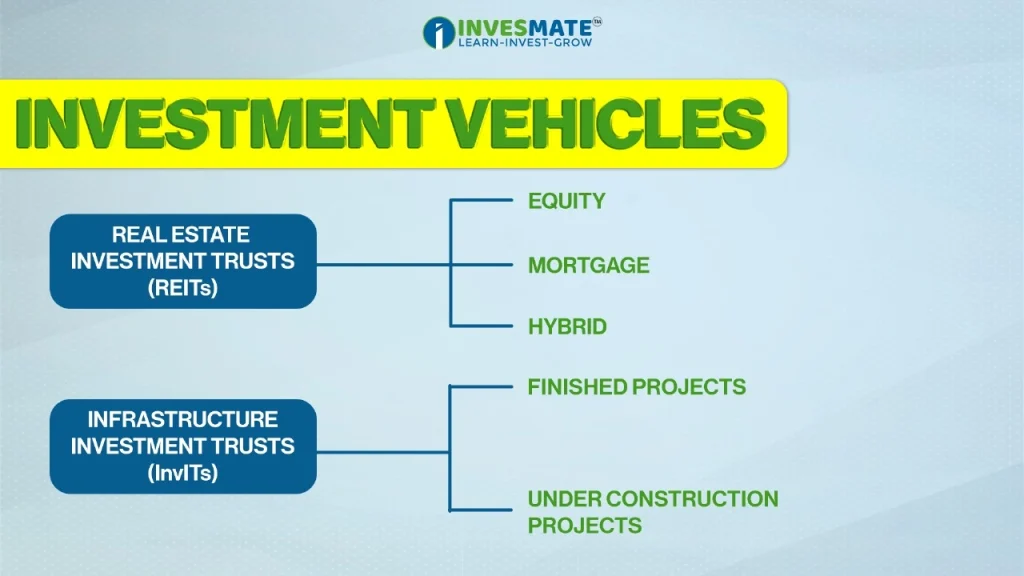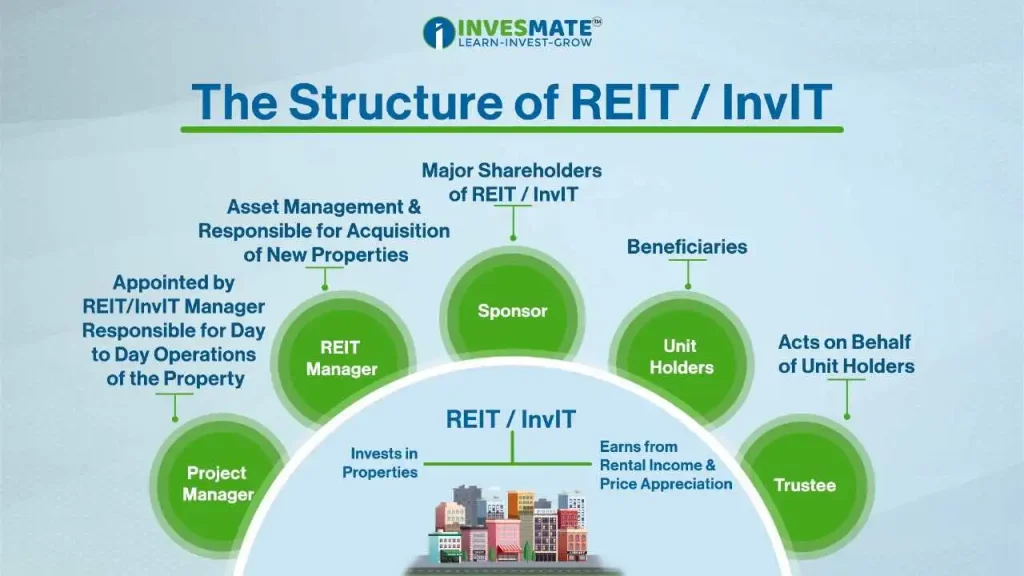Real estate is considered a popular investment option in the world of investment as it provides both capital appreciation and regular income through rent or lease payments.
A real estate investment trust (REIT) or an infrastructure investment trust (InvIT) both are like financial tools that let people invest in real estate or infrastructure projects without buying the physical property themselves.
REITs and InvITs were introduced in the US during the 1960s and got approved for use in India by a regulatory body called Securities and Exchange Board of India (SEBI) in 2014.
What are REITs and InvITs and which one is better? We will discuss these in detail through our blog.
What are REITs?
Real Estate Investment Trusts or REITs provide investors an easy entry point into the real estate market. Like Mutual Funds they pool money from investors and invest across office buildings, malls, and apartments.
The main objective of REITs is to generate regular income and long-term capital appreciation through investment.
REITs include various asset classes, such as residential properties, office spaces and hospitals, as well as infrastructure assets, such as fibre cables, telecommunication towers and energy pipelines.
What are InvITs?
Infrastructure Investment Trusts or InvITs focus on big infrastructure projects like roads, highways, power plants etc. When you invest in an InvIT, you’re putting money into these big projects. In return, you get a regular income through dividends and long-term capital appreciation.
Long-term investors are particularly attracted to REITs because of their ability to generate stable cash flow over a long period of time.

Since these instruments are new in the Indian investment landscape, there is a lot of uncertainty regarding their efficacy and benefits.
Let’s find out what they are and how they differ from each other.
Differences Between REITs and InvITs
The two investment vehicles REITs and InvITs allow investors to invest in real estate and infrastructure properties, respectively, in an affordable and more convenient way.
Let’s know the key differences between REIT and InvIT:
1. Structural Variations :
Structurally akin, REITs and InvITs aggregate capital from investors, facilitated by a trustee, sponsor, and manager.
- REITs primarily invest in finalized and ongoing real estate ventures, mandating 80% of assets in completed income-generating properties.
They cannot invest more than 20% in unfinished properties or real estate company debt/shares with less than 75% real estate revenue.

- Conversely, InvITs focus on various infrastructure such as roads, power plants, similarly completed income-producing projects are mandated to have 80% assets.
They restrict to invest more than 20% in other eligible investments. Additionally, InvITs cap investments in unfinished projects, infrastructure debt, or shares not deriving less than 80% income from infrastructure, and cannot exceed 10% of the InvIT’s value.
2. Revenue Generation and Stability :
- REITs primarily invest in commercial real estate, leasing or selling properties to generate revenue, mandated to allocate 80% of assets to income-generating properties.
REITs distribute 90% of income to investors as dividends, with the option to reinvest sale proceeds or distribute to unitholders.
- InvITs hold operational infrastructure assets like gas pipelines, roads, and power transmission lines, ensuring steady revenue through long-term contracts.
InvITs also distribute 90% of net distribution cash flow, with reinvestment or distribution of sale proceeds.
REITs offer stability with rental contracts ensuring consistent income, while InvITs’ cash flows depend on various factors, potentially impacting utilization rates.
3. Risk Factors :
- Non-traded REITs pose unique risks, including valuation opacity, illiquidity, and potential lock-in periods. Moreover, upfront fees can significantly erode overall returns.
Publicly-traded REITs face the primary risk of interest rate fluctuations, where rising rates often lead investors to seek safer options despite potential economic indicators favoring REIT performance.
- InvITs suffer from uncertainty regarding project valuation and dependency on infrastructure usage predictions, exposing investors to potential revenue shortfalls.
Project failure risk in InvITs transfers the burden to investors, particularly if revenue projections based on factors like toll collection fail to materialize.
Political or regulatory changes present significant risks for InvITs, as alterations in government policies can undermine previously granted concessions, impacting profitability.
4. Minimum Investment Requirements :
- For REITs, the minimum subscription amount for REITs is Rs10,000 – 15,000. Earlier it was Rs 50,000.
- For InvITs, the minimum subscription amount for InvITs is Rs 10,000 – 15,000. Earlier it was Rs 1,00,000.
5. Liquidity and Accessibility :
- REITs generally offer higher liquidity due to lower unit prices and greater familiarity among retail investors with real estate investments.
- Conversely, InvITs may have lower liquidity and could be less accessible due to their higher unit prices.
6. Growth Outlook :
- REITs growth is visible through redevelopment, new construction, or asset acquisitions.
- InvITs growth is gauged through bidding processes for concession assets, which may be less transparent.
REIT vs InVIT: Which is better ?
Both investment vehicles have their own advantages and disadvantages. The suitability of each investment depends on the individual investor’s investment objectives, risk tolerance, and financial situation.
REITs are highly liquid and offer stable income, but due to their popularity, they are traded more on the stock exchange and are prone to market volatility. InvITs, on the other hand, are less liquid, offer less stable income than REITs and are prone to regulatory and political risk. However, they allow you to participate in major infrastructure projects of the company.
FAQs
REIT stands for Real Estate Investment Trust. It’s like a company that owns, operates, or finances income-producing real estate.
REITs make money mainly through rental income from properties they own, and sometimes by selling properties for profit.
Yes, REITs can be suitable for long-term investing due to their potential for stable income and growth over time.
Yes, you can buy and sell REIT shares on stock exchanges just like stocks.
InvIT stands for Infrastructure Investment Trust. It’s like a fund that invests in operating infrastructure projects like roads, bridges, power plants, and pipelines.
You can invest in an InvIT by buying units of publicly traded InvITs through a broker, or through private InvITs offered by financial institutions.
Yes, InvITs can be suitable for passive income as they provide regular income distributions to investors.



Leave a Reply